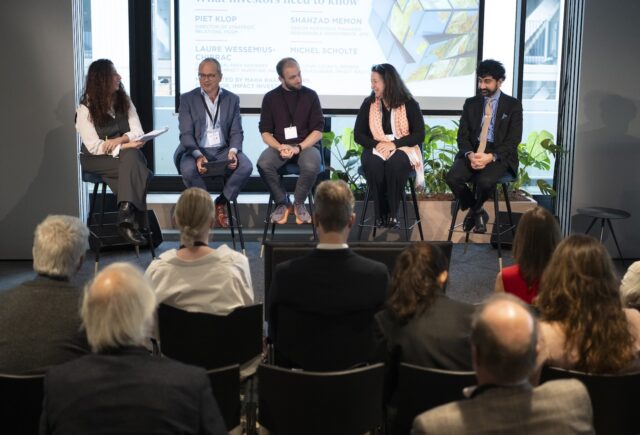The German investor believes offering financial incentives to companies if they hit social impact targets should play a greater role in investment strategies.

Roots of Impact (ROI) is seeking to build momentum behind impact-linked finance (ILF) – an investment technique the Frankfurt-based company helped to pioneer – by encouraging its wider use, either as part of blended finance or directly from impact investors.
The company has just closed its first financing round, funds from which are intended to help scale up its activities, which are increasingly focused on building infrastructure needed to better establish ILF in the market and bring others into the field, in addition to the management of ROI’s own impact-linked funds.
Practising what it preaches, ROI’s financing round is itself structured as ILF, with the company set to be financially incentivised to grow the ILF market.
Investors include the Delta Fund, the European Social Innovation and Impact Fund (ESIIF), and BMH, the public investment arm of the German state of Hesse. The Swiss Agency for Development and Cooperation(SDC), a long-time collaborator with ROI on developing ILF, provided catalytic funding to the round. The size of the financing has not been revealed, though ROI said it was a seven-figure amount.
ILF is essentially the provision of financial incentives to market-based enterprises to produce additional social impact that would not happen without those incentives, often as part of financing deals to fund their wider activities. That contrasts with social outcomes contracts or social impact bonds, which are mainly aimed at attracting investment to social enterprises focused on achieving impact goals. As ROI puts it: “ILF is about tweaking enterprises towards better outcomes, not about paying for social interventions”.
ILF has its roots in social impact incentives (SIINC), a concept pioneered by ROI and SDC eight years ago. SIINC provides cash incentives to enterprises to achievement positive outcomes conditional on raising investment – so an investor makes a repayable investment, while an outcome payer such as a DFI or government makes premium payments based on social outcomes.
SIINC was first applied by ROI and SDC in Latin America in 2016, mainly as a blended finance technique. Since then, the partners have sought to broaden the scope of ILF, developing more techniques that could be use directly by both impact investors and the blended finance world.

“With a little bit of creativity, you can tweak any financial instrument to become an impacting-linked finance instrument, because there are always terms you can adjust in relation to impact,” Bjoern Struewer, Roots of Impact’s founder and co-CEO told Impact Investor.
“In a loan, you can adjust the interest rate. In a more innovative structure, for example, you could have a repayment cap that you reduce depending on level of impact, so the company has to pay back less. You can even embed ILF in equity investments,” he said.
Tangible outcomes
ILF has typically been used in areas where tangible outcomes are relatively easy to measure, such as encouraging greater participation and advancement of women in a workforce or customer base, or incentivising power companies to provide costly “last mile” connections to rural communities from an electricity grid.
One example from ROI’s own portfolio is Mexican healthcare provider Clínicas del Azúcar, which was incentivised with SIINC payments to reach more “bottom of the pyramid” patients with its diabetes’ treatments as the company scaled up its operations. Another is Khmer Water Supply Holding (KWSH), where payments were made depending on the number of poorer communities to which it provided piped water.
Struewer said ILF worked best in making impact if the investee company had a clear idea about the impact they could make and realistic targets they could hope to meet.
“It’s not about us telling them: hey, what about your proportion of bottom-of-the-pyramid clients – can you Increase that? it’s them telling us, I could do this if you help me. Then you have a conversation, and they typically come back with very exciting ideas,” he said.
Blended finance potential
ILF should become more widely adopted technique in the blended finance toolbox and beyond, Struewer argued.
“For me, impact-linked finance is also a form of blended finance, where for the catalytic part of blended finance, you know exactly what you are going to get and how you should size it. For many sectors and topics, it can be the better form of applying blended finance,” he said.
He is optimistic about the prospects for wider adoption of ILF, as might be expected for a CEO that is using ILF incentives as part of his own company’s fund-raising.
“We are shifting our focus from managing our own funds, though we will continue doing that, to put much more emphasis on helping others do the same. This whole strategy works if the overall market grows. So, we want to grow the pie, not defend our market share in a smaller pie,” he said.
As part of its drive to popularise ILF, ROI recently published a report, in which it discusses the evolution of ILF and where the sector could go next.
The details of what targets ROI will need to meet to trigger financial incentives for its own ILF package are due to be hammered out over coming months. However, Struewer is hoping he is pushing at a door that is already swinging open, given elements of ILF are increasingly being woven into impact investment and blended finance packages.
In May, British International Investment (BII), the UK’s DFI, said it was committing €25m in debt financing to Sonatel, the largest telecoms operator in Senegal, as part of an €87m financing package with the International Finance Corporation (IFC) and French development agency Proparco. The financing package ties the pricing of the loan to targets relating to getting more women into management positions in Senegal and expanding Sonatel’s digital skills programmes.
In December, impact investor Acumen launched Hardest-to-Reach, a $250m initiative to develop clean energy markets in underserved parts of Africa. In addition to grants and equity, the initiative is using an impact-linked financing approach to meet the needs of off-grid energy companies as they develop.





